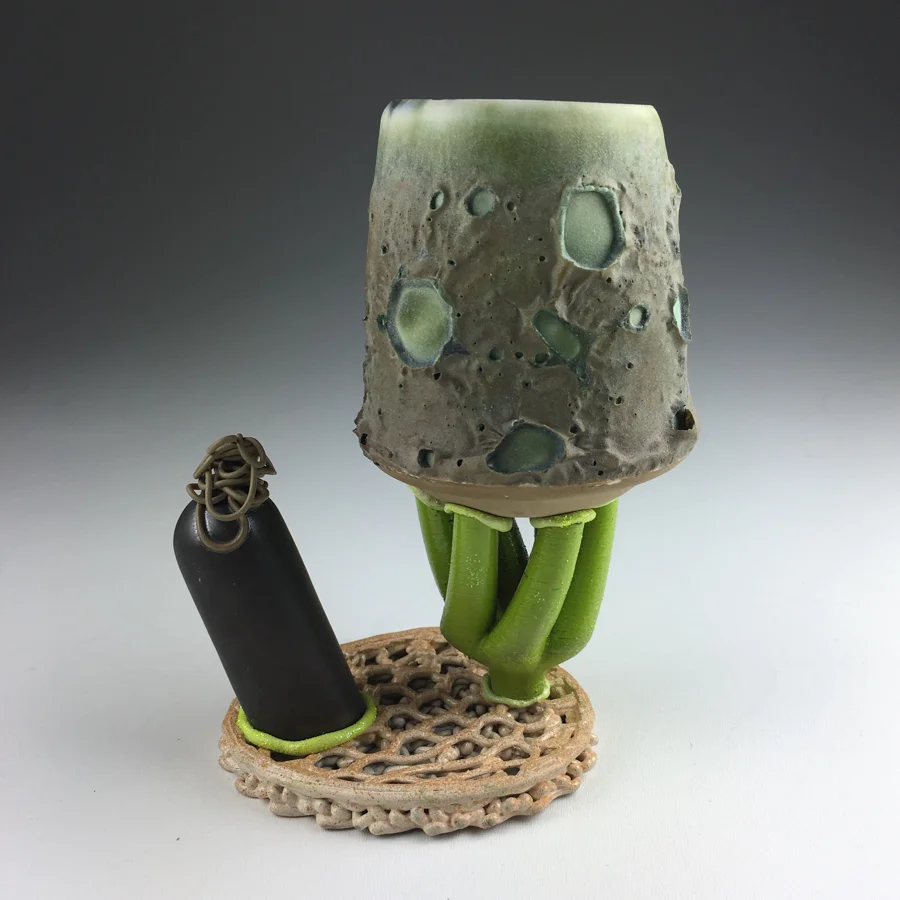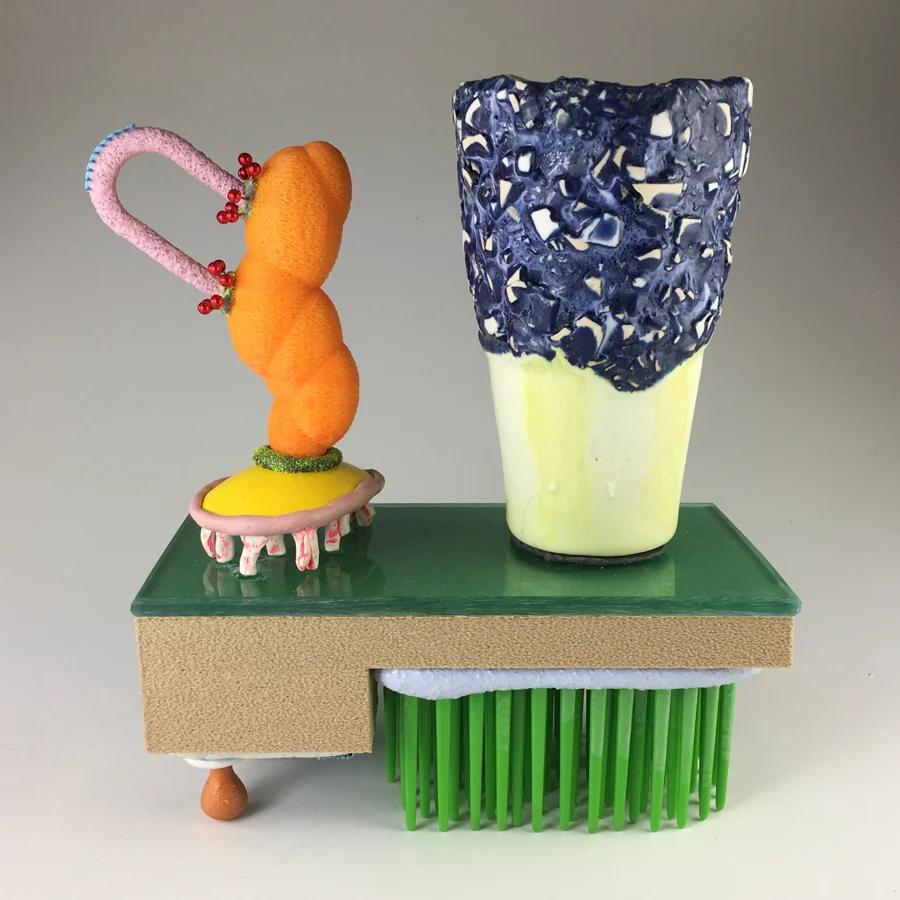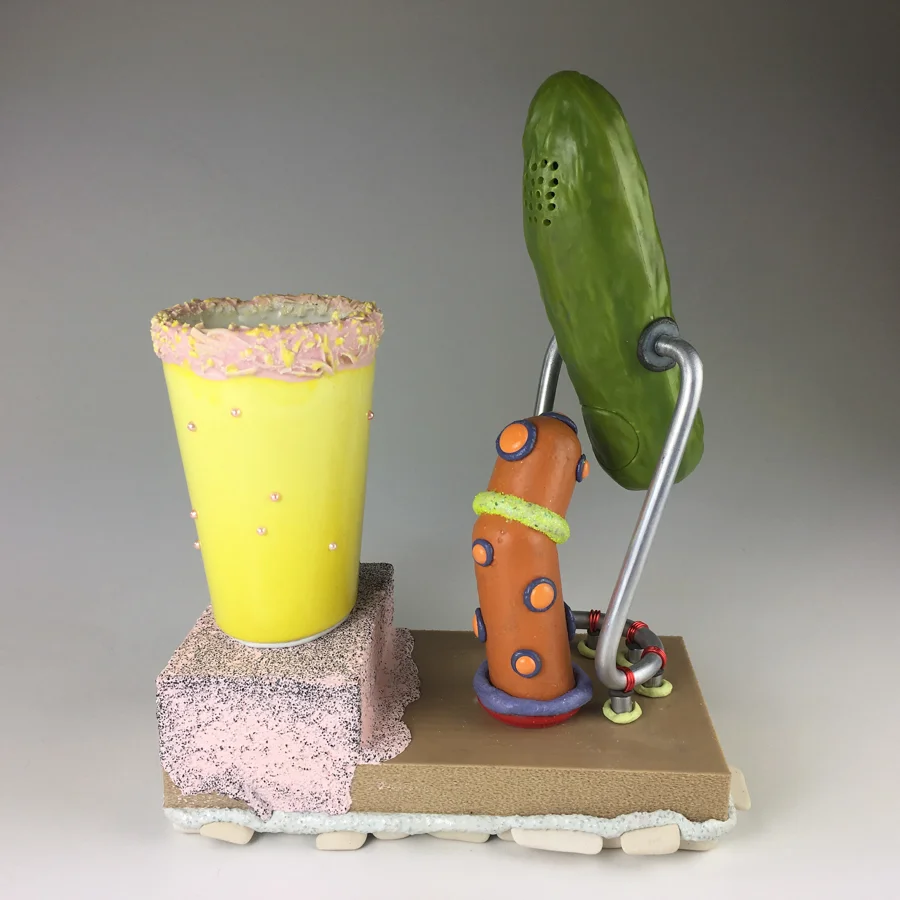Matt Mitros
Matt Mitros was born in Philadelphia, PA. Upon completing his BFA in Ceramics at Penn State University, he was an Artist-In-Residence at Arrowmont School of Arts & Crafts as well as the Archie Bray Foundation. Mitros completed a post-baccalaureate from the University of Illinois and holds an MFA from the University of Washington. He has taught ceramics and sculpture at the University of Washington, South Seattle Community College, Lakeside Upper School, Kennesaw State University, and is currently an Assistant Professor of Art at The University of Alabama. In 2014 and 2017 Mitros was a Short-Term Artist-In-Residence at Red Lodge Clay Center.
In 2008 Mitros was an Artist Trust GAP (Grant for Artist Projects) recipient funded by the City of Seattle. His work has been featured in Art in America, Art LTD, Clay Times, Ceramics Monthly, and City Arts Magazine, as well as the book 500 Figures in Clay. Mitros has exhibited work throughout North America and Europe. His work is in the permanent public collections of the National Museum of Slovenia, Bemidji State University, the Spartanburg Art Museum, The Hudgens Center for the Arts, the FSU Museum of Fine Art, and others. Mitros has participated in over 160 exhibitions nationally and internation
Statement
At the intersection of sentimentalism and kitsch, Mitros’ small scale assemblages pay homage to the aesthetics of pop-culture, architecture, and nature. His arranged abstractions and collaged objects are informed by a desire to illustrate the sublime relationship between the natural and mechanized.
Interview with Matt Mitros
Questions by Andreana Donahue
Hi Matt. How were you first introduced to art and art-making growing up in Philadelphia?
I was born in Old City Philadelphia in the late 1970’s. At the time, that part of the city was not popular in the way it is now. There were many artists in the neighborhood because it was a cheap location to maintain a studio and live. Many of the people I would encounter were makers of some sort. My mother would invite artists over for dinner, and, as a thank you, they would give art to my parents, which then hung throughout our home.
You’re currently based in Tuscaloosa, Alabama. What are the benefits of living and working in this community as an artist?
I currently teach at The University of Alabama, so the decision to relocate to the South was solely motivated by the job offer. I spent eight years living in Seattle during and after grad school, so moving south (first to Atlanta for two years and then to Tuscaloosa for five years) has been quite a transition.
Were there any major changes in your creative approach or inspiration after relocating? Does the work itself have a relationship to place?
My work has become increasingly complex. I’m not sure if this has as much to do with the geographic location. Rather, it could be a bi-product of being offered a studio space and resources with which I can develop a body of work free from worries about producing something commercial and hitting a sales quota.
Can you tell us about your artistic influences? Are there artists or specific works that you keep returning to over time?
I’m strongly influenced by Ken Price, Ron Nagle, Julian Schnabel, Roxy Paine, Matthew Barney, and Jessica Stockholder, as well as the entire short-lived movement of the Memphis Group. I also think the thrown liquid lead performance/sculptures from Richard Serra in the 1970’s are powerful, though I’m not a fan of his other work. I have a ceramics background, but I completely reject the maker/craft lovefest that is going on in contemporary crafts and spilling over into the art world. It’s way too self-reverential and self-serving. The orthodoxy of material allegiance that is systemic in some creative circles is precisely why those makers will stay confined to the crafts movement. The makers who use a material but are not afraid to deviate from historic norms or expectations of how the material “should” perform will be rewarded in history as Artists who can freely move between craft and fine art. There is a clear distinction between Art and Craft. Craft is governed by a predetermined outcome and a need for refinement. Art, on the other hand, is burdened with creating an emotive experience often at the expense of craftsmanship. Many of the “art” pieces in NYC and LA are actually crafts fleeced as art.
How do you typically generate new ideas and begin working on a piece?
I have not drawn an image or sketched for about 10 years. There is a perception that an artist must sketch, doodle, draw, compose, or make scale models before they embark on an idea. I reject that notion completely! I do all of my drawing in my head during long drives. I compose and “map” a piece in my mind and then retrieve that image when needed in my studio. To that end, I am, in fact, sketching, just not in the traditional sense. Every couple years, I do a residency in Montana. Those drives are 30–40 hours, and I do all of my “drawing” while driving. No music. No talking. Just silence and “sketching” in my head.
Throughout your work you reference recognizable organic matter such as potatoes, honeycombs, or delicate flowers alongside more ambiguous plant-like forms. What sort of source material do you work from—imagery, observation, memory, or a combination of these?
I enjoy the natural world of plants; it is stubborn and preoccupied with survival. My work echoes these themes. The book, The Botany of Desire, is one recent book that informs my work.
Toys that you’ve cast in clay often appear in the work. In what other ways does pop-culture inform your ceramics?
I look at a lot of advertising and fashion as visual stimuli. It’s more of a passive process in that I’m not actively seeking source material from pop culture. I often find myself tearing pages out of magazines or taking screen shots from web pages. Occasionally, I draw upon these images when composing my sculptures. I think it’s important to take notice of what you notice.
Other than clay, you work with a wide range of media. What is your criteria for selecting materials?
Materials resonate with a process. When a material is manipulated using a new process, exciting things can happen. This can yield surprises with regard to the properties of the material itself. In turn, the viewer’s response can be one of surprise, which often has something to do with her own expectations for how a material should be used. For example, I have recently been using wood filament in one of my robotic printers.
Your work seems to have a strong connection to still life, and possibly science fiction. Would you say this is accurate?
To a degree, yes. My objects often have a campy feel that stems from being formed from disparate parts. Often, broken parts are used in awkward ways.
Many components of your assemblages reveal the process of their making, through visible mold seam lines or layers of 3D-printing. Can you talk about your ongoing interest in combining objects that are machined with those that are hand-made?
I think your question really is more about how one defines handmade. For me, the hand and mind are tethered together in a way that does not make them mutually exclusive when making art. The automation process does not disqualify the Hand. Where they do diverge, however, is in the realm of aesthetics. The automated process often leaves a mechanized mark that suggests personal detachment and multiplicity, whereas the mark of direct touch is one of uniqueness. When used together, I have always believed these two renderings of objects/parts create a compelling relationship where the origin of their formation is actually enhanced by the proximity of the other. In other words, straight lines get really straight when placed next to a curve, and visa versa.
Your sculptural mugs and cups bring to mind Ken Price’s surreal and sometimes absurd cups from the 1960’s. Can you elaborate on the intentions and ideas behind this series?
It’s really about my rejection of material orthodoxy and the pastiche direct appropriation of historical sources which we are taught to draw upon when sourcing our subjects as makers. So many of my artist friends feel a need to pay homage to the great masters of ceramics by being referential to them or to the history of ceramics. Some believe that if it’s made from clay, it needs to be glazed or even fired. I have never struggled with finishing a sculpture because I don’t have the right ceramic glaze. I have found that I can easily paint it, rub it with roofing tar, smear it with concrete, or soak it in beet juice to achieve the desired finish. Ken Price, Ron Nagle, Howard Kottler, and others found a nice balance between knowing the history of the material they were using and understanding that bringing the idea to fruition often required using a different technique not typically associated with the ceramic arts.
You manipulate clay through various methods—slip-casting, hand-building, throwing, as well as the use of tools not traditionally associated with ceramics, like 3D printers and CNC routers. How did you start working this way? Can you tell us about your overall process?
I first converted a pottery wheel into a resin centrifuge in 2005, and I have been interested in projection mapping for quite a while. To be honest, the introduction of technology in my studio practice was quickly accelerated when I took a workshop at Anderson Ranch a few years ago led by an amazing artist named Del Harrow. Those two weeks in the Rockies were transformative.
Can you share your perspective on the effect technology and social media have had on contemporary art or our current culture in general?
I have mixed feelings about this. I love Instagram because it’s a platform where a maker can share an idea, art piece, or process with the viewing public. However, it is also where bad taste, bad art, and poor craftsmanship can thrive due to the general public’s inability to identify redundancies, mimicry, and risk taking. I don’t fault the users of social media at all! Not everyone is fortunate enough to travel the world and visit museums. Social media is like a swimming pool: there is a deep end that is refreshing and safe for diving, but the vast majority of it is composed of shallow piss-warm water that is overcrowded.
Can you tell us about your current studio and what an ideal day working is like for you? How do you stay motivated and productive?
I walk in and immediately cast some objects in resin or porcelain and then try to understand what I made the night before. My studio is filled with parts/shapes. I try to capture the energy of the specific sculpture that is in my head by looking for the components needed to assemble it. If I don’t have what I need to move on with completion of that piece, I assemble what I can at that moment and move on to the next drawing in my head. I usually have 8-12 pieces going at one time. I love the problem-solving aspect of what I do. If I don’t have the shape I need for my 3D collages, I see if I can make it by hand. If not by hand, I search for a found object to be transformed. If the found object doesn’t work, I get on the computer and design an object using CAD software and then output on one of my clay or plastic printers. I shamelessly move between mediums and ways of working.
What have you been reading, watching, or listening to lately?
I don’t really watch that much TV, but the coverage of the Donald Trump presidency has consumed my evenings these days. I studied philosophy before moving to art, so I’m reminded of some of Jean Baudrillard’s essays on reality as I process this era we are experiencing. As far as music goes, I’ve been going through a sort of renaissance listening to Kid Koala and DJ Shadow quite a bit. Handsome Boy Modeling School has returned to my audio lineup, too.
Do you own other artists’ work or maintain any other collections?
I have an eclectic collection of mugs/cups which functions now as a type of a scrapbook of memories to some degree. You see, each time I trade someone for a cup or buy a cup from someone I know or admire, I am reminded of a story, emotion, or memory of that particular maker.
What are some of your interests outside of art-making that others might find surprising?
I enjoy flowers, gardening, beer brewing, and motorcycles. What these things share is the capacity to innovate as a user or maker. I love engineering parts which make my 2006 Buell Ulysses function better. I celebrate the symbiosis of different plants in a garden. The manipulation of ingredients to create a new beer recipe is fascinating to me. I suppose this all has something to do with alchemy.
You’ve traveled frequently as a visiting artist and lecturer, in addition to providing workshops. How have these experiences been beneficial to or shifted your practice?
They really don’t. It’s more of a way to share ideas and meet a new audience. I don’t subscribe to the idea that the artist needs to keep their artmaking process secretive or the idea that one’s process is somehow “their own”. I used to spin records in college, and if you study the history of sampling and beatboxing you will see it was originally a vicious and competitive arena for creativity. The term “biting” refers to someone taking a DJ’s innovation and adopting it as their own. This created a situation where there was constant innovation and exploration. Art is no different. If a student wants to take something I do and use it to accelerate their development I completely support that and salute their motivation.
You also curate and organize exhibitions. What are some qualities you tend to appreciate or find yourself attracted to most in other artists’ work?
I absolutely love organizing an exhibition or curating a show. Each endeavor is unique, and I seek out different artists specific to the theme. It feels just like the way I make art or spin records: it’s all a collection of sources that are arranged or collaged to create a composite new THING.
What are you excited about working on in the studio right now? Do you have any upcoming projects, residencies, lectures, or other news you’d like to share?
I’ve been obsessed with reconstructing notions of pottery (mugs) by challenging expectations of how the architectural parts of the vessel are arranged or placed. I have been doing this with radical use of materials typically not associated with vessel making but also with composition. I have a solo show in March where I will be presenting these works. I’m essentially trying to sculpt emotional and cultural echoes of The Mug. Echoes are sound waves we perceive which degrade over time as they bounce around an environment or space until the wave length dies. This show is called “low-poly ECHOES”. After this, I hope to start making light fixtures I have drawn up in my head.
To find out more about Matt and his work, check out his website.











